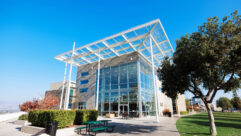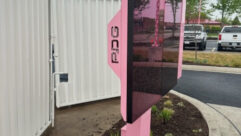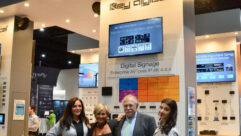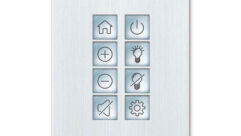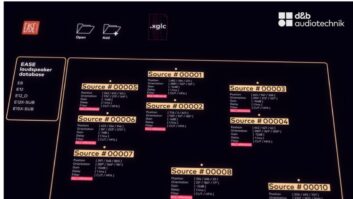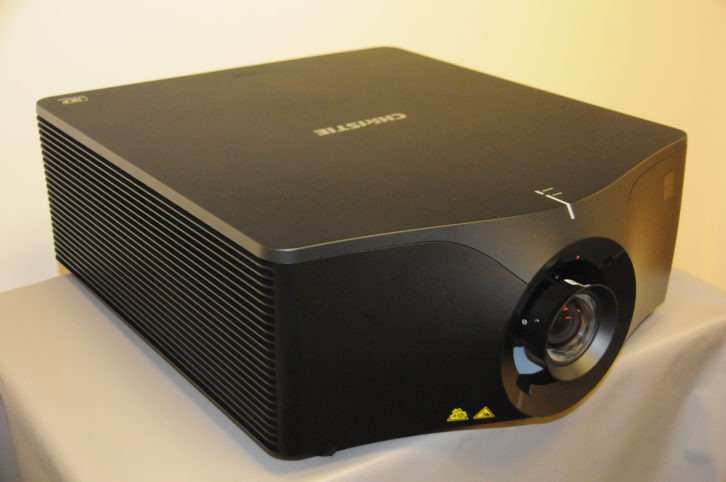
Christie Digital is bringing the features and capabilities from their high-end projection products to more of their line up. I had the opportunity to spend time with the DHD850-GS laser-based projector. What I found was a projector with a well-developed set of features that are squarely aimed at the gap in the currently available display options. We need laser-based projectors for medium to large spaces that will be low maintenance and provide enough brightness for the correctly sized screen.

The projectors that have provided brightness of over 10,000 lumens are expensive, in part because they have been built around 3-chip DLP engines. Until now, the single-chip projectors have not been nearly as bright. Christie Digital has developed the DHD850-GS to fill this gap. It is a single-chip, DLP engine powered by a laser-phosphor light source.
The Christie Digital DHD850-GS is a HD1080 resolution, 16:9 aspect ratio projector with a maximum light output of 6900 ANSI Lumens. This projector is not lightweight, coming in at just over 52lbs, but since it has been designed for installation in larger venues, the size and weight should not be of major concern. One advantage of the size is that the air-flow required to keep the engine cool can be a higher volume and lower velocity. This is evident when considering the noise generated by the projector. I was able to verify the respectable 35dBA specification in standard mode. Since I was interested in just how quiet the projector is, I also verified that the unit I had met the very quiet ECO mode rating of 32dBA.

The projector provides electrically operated horizontal and vertical lens shift. The amount of lens shift does vary slightly by the lens you use, but in general, the available lens shift is quite sufficient for most installation applications. Christie has provided the DHD850-GS with a minimum vertical lens shift of ±119% and a minimum horizontal lens shift of ±29%. With this broad range, the projector accommodates those installations that need a little flexibility in the mounting position.
I am often surprised by the features that find their way into projectors aimed at the integration space. It is the small things that can be of great value. As I looked over the DHD850-GS, I found a number of thoughtful features. I want to highlight a few.

First, since the projector accommodates a variety of lenses, the method of lens mounting can be an issue. In the case of the DHD850- GS, I found the lens mounting configuration well-developed. It was relatively easy to install the short-throw, zoom lens that Christie Digital provided for my testing. More significantly, the lens fit snugly into the projector and was held tightly in place when seated as directed by the operations manual. Lens stability is critical to focus and in particular, edge focus. The important issue is that when installed, the lens stays in proper alignment. The combination of lens diameter, the opening in the cowling where the lens fits into the projector, and my somewhat large fingers required the use of a “tool” to release the lens for removal. I will admit that I chose to use a chopstick to depress the release button when removing the lens.
As I mentioned above, this projector does not come with a standard lens. However, Christie Digital has provided a very broad range of lenses from which to choose. All of the lenses for this projector except for one, are zoom lenses.
To continue the thought, one consideration I give to projectors with interchangeable lens options is whether there are any gaps in the lens ranges. Christie has carefully configured the range of available lenses so that there is contiguous coverage in throw distances from the shortest to the longest zoom lens. This may not appear to be an obvious advantage, but when I need to mount a projector, invariably the physical restrictions can conflict with the throw distance if restricted by the lens choices. One last lens comment; Christie has provided one fixed lens in the line. It is the very specialized lens for extreme short-throw applications. It is a .36:1 lens that will create a 120-in. diagonal image with a throw distance (TD) of just over 37.5-in.

The DHD850-GS has a very robust array of connections that make this projector a valued asset to many applications. Of course, I found the compulsory input connections (VGA, HDMI, and DVI-D) to which Christie Digital has added HD-SDI, and 3D Sync. Further, there are loop-through connections for the HDMI, HD-SDI and 3D sync signals. One surprise that I got when I opened the cover over the connectors was that both the HDBaseT and the LAN connectors were not just the typical RJ45 network connector, but instead were Neutrik Ethercon connectors. These connectors provide much greater stability (read that as much less likely to fail) connections.
There was one more surprise as I looked over the projector, when I found an HDMI connector on the bottom (mounting surface) of the projector. So often, aesthetics matter and when we mount a projector in a space. The cables we have to connect are often a messy part of the installation. This connector position provides a means to keep the visible connections to a minimum.
Christie Digital claims a commitment to color, so let’s unpack that element a bit. I realize that most projectors that get installed do not get an in-depth color correction set up. Christie Digital has incorporated features to assist with initial color correctness and to keep the image looking that way. The company now has modes that provide consistent image performance over a long period of time. The Constant Power and Intensity modes provide for long-term consistent light level and color by using an internal sensor to maintain the initial settings. One of the color-space features that I look for is the ability for a display to emulate DICOM color space. If a display is to be used in any healthcare application, this should be considered as a must.

Like many manufacturers, Christie has also come to the market with proprietary color technology—what they call BoldColor Technology. The BoldColor engine is designed to provide a more color-balanced source for illumination by the use of two lasers, Blue and Red, as well what the company describes as a patented optical chamber, which in combination with software, produced more saturated colors. You can find more information in this Christie infographic and FAQ.
What does this mean to my eye? As I tested the DHD850-GS, I found that I was able to use the tools that Christie Digital has provided within the projector to get a very color-accurate picture. When I do testing, I take the time to see how close I can come to the published performance of each projector. In the case of the DHD850-GS, I was able to exceed the published performance. Beyond color you may have the need for creating unique geometry. This may be a very wide image or the display of an image on surface that is not flat. The Christie DHD850-GS has a setting (PC mode) that provides for blending or warping with the use of an application from Christie Digital. While the ability to blend or warp may not be on your agenda, the capability can be an asset to an installed projector. The benefits of these features to a single projector application are significant. Having added control over geometry and color control may be just what you need for your use.
In past reviews, I have often commented on the network connectivity for display devices. As we continue to make the network the means of control and management, network capabilities of a projector are not just a nice thing, but a must. Looking for more efficient ways to manage the AV assets, we have seen many projectors that can be connected to a network, but for what reason? We have seen projectors that can generate an email. While this has been helpful, an email requires a person to receive and respond to the message. I have to commend Christie Digital for doing much more. They have provided Simple Network Management Protocol (SNMP) support. As remote management gains adoption, the ability to set up a device, such as the DHD850-GS, as a networked appliance becomes a requirement. With this capability, we can “trap” specific operating functions.
What this means is that you can monitor the projector from a software platform, set parameters of normal operation and then have the monitoring software let you know if the monitored device is not operating within the limits you chose to set. Examples would be internal temperature, fan speed, or lamp hours. If you have more than a few rooms to manage, this is a big time and money-saving solution.
The Christie Digital DHD850-GS is a very capable projector for medium to large space applications. From the accuracy of the color to the dual laser-based illumination, and the ability to be remotely managed, this projector will provide a consistently high-quality image for a long time with next to no maintenance.
PRODUCT SUMMARY
COMPANY: Christie Digital
PRODUCT: Christie Digital DHD850-GS projector
PROS: Quiet, high brightness, laser engine, color accuracy, extensive adjustments, capable of blending and warping
CONS: Lenses sold separately, size and weight
APPLICATIONS: Installed projection for larger training rooms, conference rooms and specialty applications
PRICE: $13,299 MSRP (less Lens)
SPECIFICATIONS
ENGINE TYPE: 1-Chip DLP, Two Laser (Red and Blue) Phosphor
NATIVE RESOLUTION: HD1080 (1920×1080)
BRIGHTNESS: 6900 Lumen
THROW RATIO AS TESTED: 0.95 – 1.22:1 ($2055.00 MSRP) other lenses available
INPUT CONNECTIVITY: Analog and digital, including HDBaseT. HDMI and HD-SDI
NETWORK CONNECTIVITY: Wired and optional Wi-Fi
LENS SHIFT V: ±119%, H: ±29%
FAN NOISE: 35dB (at full light output)
UNIT WEIGHT: 52.4lbs. (23.7kg)
DIMENSIONS: 19.2in. (480mm) x22.2in. (555mm) x 7.6in. (190mm)


